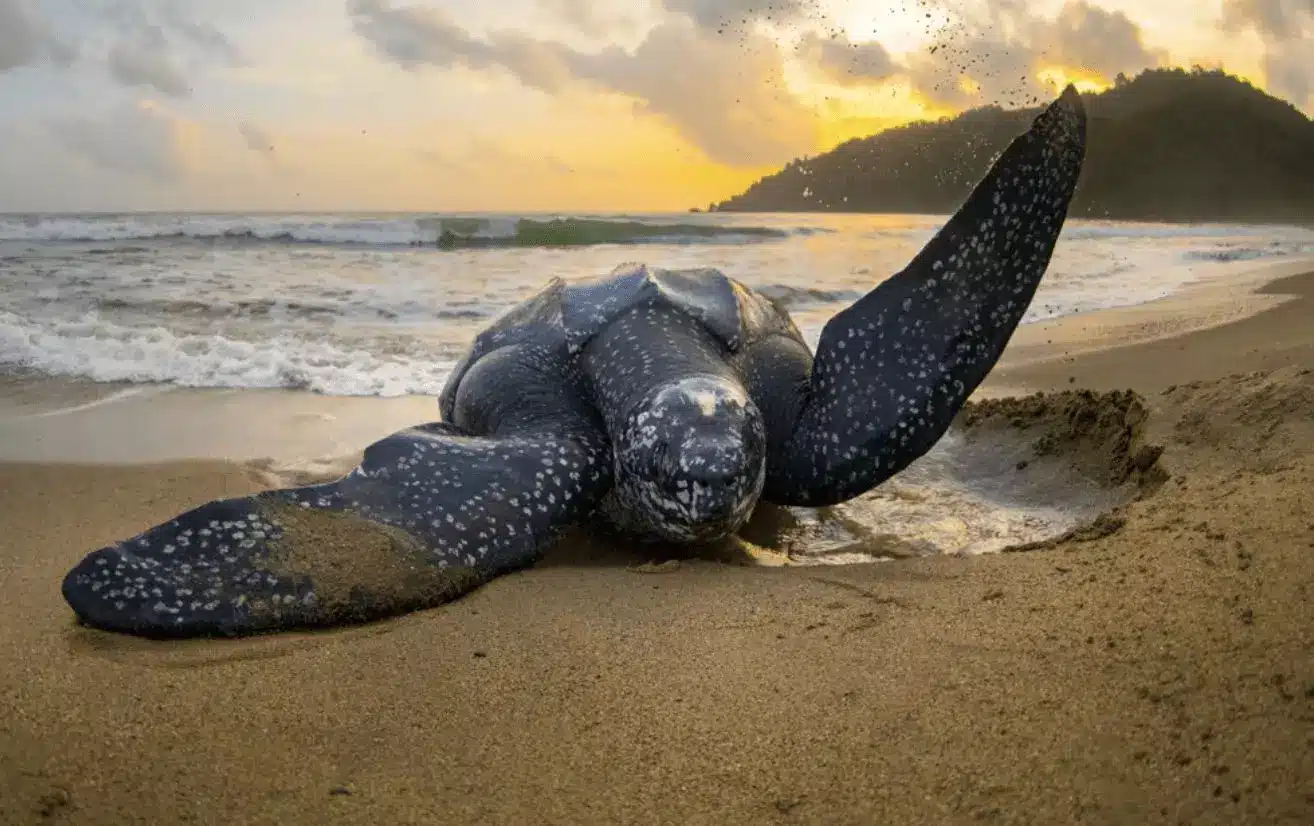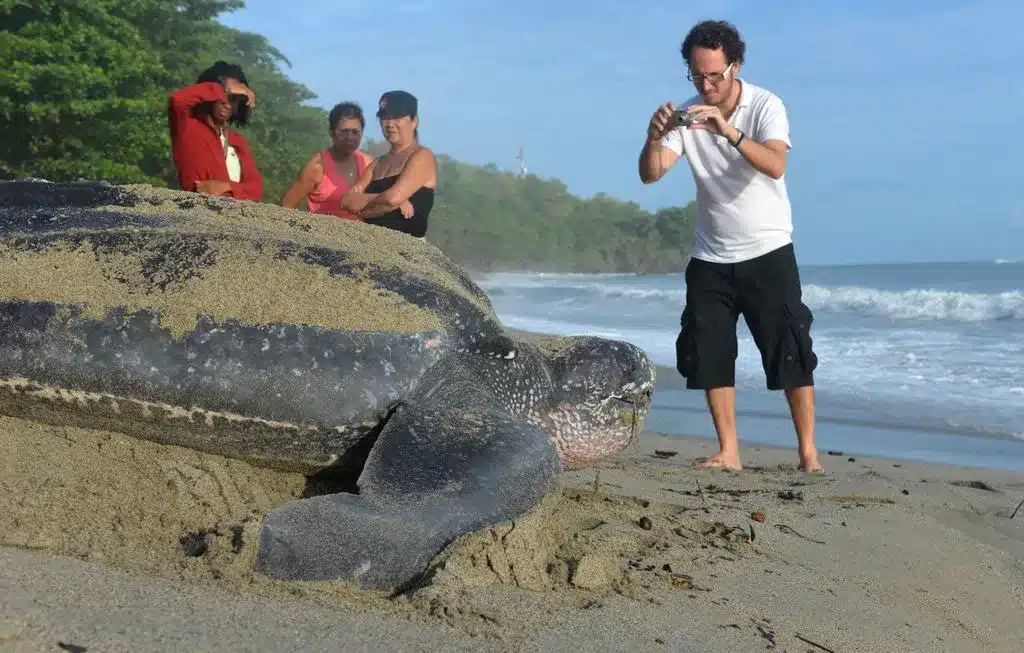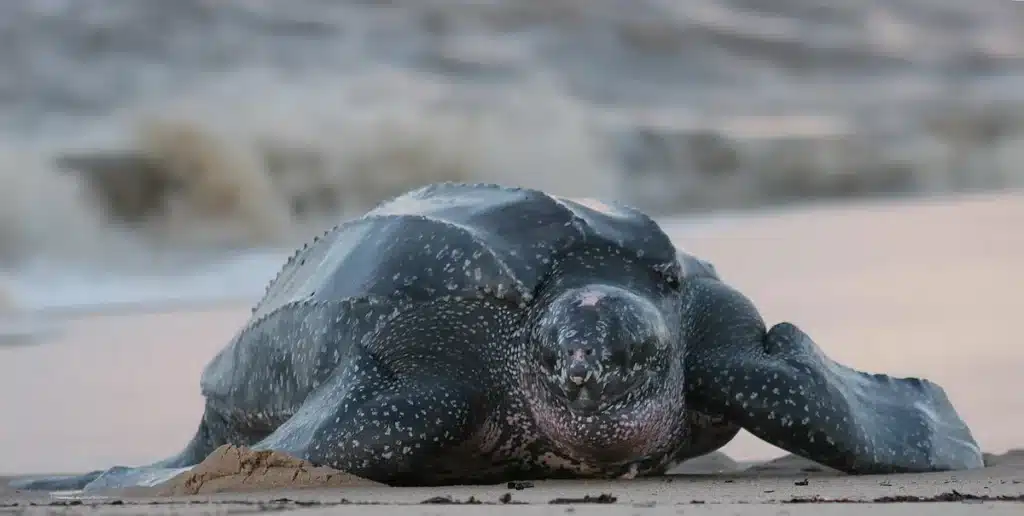What Is The Largest Sea Turtle

Introduction
What Is The Largest Sea Turtle: The largest sea turtle on Earth, the leatherback turtle (Dermochelys coriacea), is a magnificent and awe-inspiring creature that captivates both marine enthusiasts and conservationists alike. This remarkable species stands out not only for its impressive size but also for its unique characteristics and crucial ecological role within the world’s oceans.
The leatherback turtle is an oceanic giant, with some individuals reaching lengths of up to seven feet and weighing as much as 2,000 pounds. This immense size sets it apart from all other sea turtle species, making it a true marvel of the natural world. Its distinguishing feature is its distinct leathery skin, rather than a traditional bony shell, which helps it adapt to the colder waters of the open ocean.
These turtles are renowned for their remarkable ability to migrate vast distances across the world’s oceans, traveling thousands of miles in search of food and suitable nesting sites. Despite their enormous size, leatherbacks are powerful swimmers and are well-equipped for life in the open sea.
However, the leatherback’s impressive size and unique characteristics are not the only reasons it garners attention. These sea turtles play a vital role in marine ecosystems by helping to control jellyfish populations, which, if left unchecked, can disrupt the balance of marine food webs.
Intriguing, enigmatic, and ecologically significant, the leatherback turtle holds a special place in the hearts of those who study and appreciate the wonders of the ocean. This remarkable creature serves as a symbol of the importance of marine conservation and the need to protect the fragile ecosystems of our oceans.

How long can the largest sea turtle grow?
Leatherbacks are the largest turtles on Earth, growing up to seven feet long and exceeding 2,000 pounds. These reptilian relics are the only remaining representatives of a family of turtles that traces its evolutionary roots back more than 100 million years.
The largest sea turtle, the leatherback turtle, can grow to remarkable lengths. These impressive marine giants can reach lengths of up to seven feet (2.13 meters) and weigh as much as 2,000 pounds (907 kilograms). Their immense size sets them apart from all other sea turtle species, making them the undisputed champions of the ocean in terms of sheer size and bulk.
The leatherback’s colossal dimensions are a marvel of nature, and they are well-suited for their oceanic lifestyle. Unlike other sea turtles, which have hard, bony shells, the leatherback’s shell is leathery and flexible. This unique adaptation allows them to navigate the colder waters of the open ocean, where they often dwell.
Their extraordinary size and physical characteristics are a testament to their evolutionary journey and their ability to thrive in the world’s oceans. It also highlights the vital role they play in marine ecosystems, particularly in regulating jellyfish populations.
The largest sea turtle, the leatherback, can grow to astonishing proportions, reaching lengths of up to seven feet and embodying the grandeur and wonder of Earth’s marine biodiversity.
What can humans do to protect adult sea turtles?
Keep nesting beaches dark and safe for sea turtles. Turn off, shield, or redirect lights visible from the beach. Lights disorient hatchling sea turtles and discourage nesting females from coming onto the beach to lay their eggs. Do not disturb nesting turtles, nests, or hatchlings.
Protecting adult sea turtles is crucial for the conservation of these magnificent creatures. There are several actions humans can take to ensure their safety and well-being:
- Reduce Plastic Pollution: One of the most significant threats to adult sea turtles is plastic pollution. Plastic bags and debris in the ocean can be mistaken for jellyfish, a common prey for sea turtles, leading to ingestion and often death. Humans can reduce plastic pollution by using reusable bags, bottles, and containers, and properly disposing of plastic waste.
- Responsible Fishing Practices: Commercial and recreational fishing can unintentionally harm adult sea turtles through bycatch, where turtles are caught in fishing gear like nets and hooks. Supporting sustainable and responsible fishing practices, such as using turtle-friendly equipment, can help reduce this threat.
- Beach Conservation: Many sea turtle species nest on beaches, and human activities near nesting sites can disturb or harm adult turtles. Conservation efforts include protecting nesting areas, reducing beachfront lighting, and minimizing beachfront development to ensure that sea turtles can safely lay their eggs and return to the ocean.
- Marine Protected Areas: Advocating for and supporting the establishment of marine protected areas (MPAs) can provide safe habitats for adult sea turtles where fishing and other activities are restricted or prohibited.
- Education and Awareness: Raising awareness about the importance of sea turtles and the threats they face can encourage individuals and communities to take action. Educational programs and campaigns can help people understand the critical role of these animals in marine ecosystems and inspire conservation efforts.
By taking these steps, humans can contribute to the protection and preservation of adult sea turtles, ensuring their continued existence in our oceans.
What is the largest threat to sea turtles?
Sea turtles need to reach the surface to breathe and therefore many drown once caught. Incidental capture by fishing gear is the greatest threat to most sea turtles, especially endangered loggerheads, greens, and leatherbacks. This threat is increasing as fishing activity expands.
The largest and most pervasive threat to sea turtles is human activity. Several human-related factors contribute to the decline of sea turtle populations worldwide:
- Habitat Destruction: Coastal development, including the construction of resorts, hotels, and infrastructure, often leads to the destruction and degradation of sea turtle nesting habitats. Beachfront lighting can disorient hatchlings, preventing them from reaching the ocean.
- Pollution: Marine pollution, particularly plastic debris, poses a significant threat to sea turtles. These creatures often mistake plastic bags and other debris for jellyfish, a common prey item, leading to ingestion and potential harm. Chemical pollution and oil spills can also contaminate their habitats.
- Fishing Bycatch: Sea turtles can become entangled in fishing gear, such as nets, longlines, and hooks. This unintentional capture, known as bycatch, can injure or kill sea turtles. Some fishing practices, like trawling, can have particularly devastating impacts.
- Climate Change: Rising global temperatures and ocean temperatures have several consequences for sea turtles. Changes in sea temperature can affect their nesting habitats, and the increasing frequency of extreme weather events can destroy nests. Climate change can also influence the sex ratios of sea turtle hatchlings.
- Illegal Poaching: The trade in sea turtle products, including their shells, meat, and eggs, continues to persist in some regions despite international conservation efforts. Poaching poses a direct threat to sea turtle populations.
Addressing these threats requires a concerted effort involving governments, conservation organizations, and individuals. Conservation measures, such as protected marine areas, sustainable fishing practices, and public awareness campaigns, are essential to safeguarding the future of these ancient and vital marine creatures.
How many babies can a sea turtle have?
The sea turtle lays up to 100 eggs, which incubate in the warm sand for about 60 days. The temperature of the sand determines the genders of baby sea turtles, with cooler sand producing more males and warmer sand producing more females.
Sea turtles, magnificent creatures of the ocean, can lay varying numbers of eggs in each nesting season. The number of eggs a sea turtle can have depends on several factors, primarily the species of sea turtle. There are seven recognized species of sea turtles, with the most common being the loggerhead, green, and leatherback turtles.
Loggerhead sea turtles typically lay around 100 to 126 eggs per nest, while green sea turtles can have larger clutches, ranging from 100 to 200 eggs. Leatherback sea turtles, on the other hand, tend to have fewer eggs per nest, usually around 80 to 100.
It’s important to note that sea turtles do not nest every year; they have a nesting cycle that can span several years. Some species nest more frequently than others, but they all share the incredible instinct to return to the same beaches where they were born to lay their eggs.
This nesting behavior is vital for the survival of these ancient mariners, as it ensures the continuation of their species. Conservation efforts worldwide are focused on protecting these nesting sites and the fragile sea turtle populations to ensure that future generations can witness these remarkable creatures in the wild.
Where does the largest sea turtle live?
The leatherback is the largest living sea turtle.
Leatherback sea turtles can be distinguished from other species of sea turtle by its lack of a hard shell or scales. Instead, leatherbacks are covered with a firm, rubbery skin. You can find leatherback sea turtles as far north as Canada and the northern Pacific Ocean.
The largest sea turtle in the world, the magnificent leatherback turtle (Dermochelys coriacea), inhabits a vast range of oceans and can be found in both tropical and temperate waters. Leatherback turtles are renowned for their immense size, with some individuals exceeding 2 meters (6.6 feet) in length and weighing over 900 kilograms (2,000 pounds).
These remarkable creatures are highly migratory and have been known to undertake transoceanic journeys. They are often found in the open ocean, far from coastal areas, making their home in the pelagic zones of the Atlantic, Pacific, and Indian Oceans. Leatherback turtles have been spotted as far north as the Arctic Circle and as far south as the icy waters near Antarctica, demonstrating their remarkable adaptability to a wide range of temperatures.
One of the most critical nesting sites for leatherback turtles is found in the warm tropical waters of the western Atlantic, particularly in places like the Caribbean and the coasts of Central and South America. These turtles travel thousands of miles to return to these nesting beaches to lay their eggs, showcasing their remarkable navigation abilities.
In essence, the largest sea turtle, the leatherback, is a true global traveler, thriving in the open oceans and visiting various regions across the world’s seas.
How big can leatherback sea turtles get?
Leatherback sea turtles (Dermochelys coriacea) are the largest of all sea turtle species, renowned for their colossal size. These incredible creatures can reach staggering lengths, with some individuals growing up to 2.8 meters (9.2 feet) and occasionally even longer. When it comes to weight, leatherbacks are equally impressive, with some weighing over 900 kilograms (2,000 pounds). Their massive size is a testament to their evolutionary adaptations, which allow them to thrive in a wide range of oceanic environments.
One of the key features that sets leatherbacks apart from other sea turtles is their distinctive, leathery shell. Unlike the hard, bony shells of other sea turtles, the leatherback’s shell is composed of a flexible, rubbery skin with embedded bony plates. This unique shell structure not only contributes to their impressive size but also enables them to dive to incredible depths in search of their primary prey, jellyfish.
The size of leatherback sea turtles is a remarkable example of nature’s grandeur, and it showcases the incredible diversity of life in the world’s oceans. Despite their enormous size, leatherbacks are also known for their grace and endurance as they navigate the vast expanses of the open ocean, making them one of the most awe-inspiring marine species.
What sets the leatherback sea turtle apart from other sea turtles?
The leatherback sea turtle, Dermochelys coriacea, stands as a magnificent anomaly among its marine counterparts. Its most distinctive feature is its shell, or rather, its lack thereof. Unlike other sea turtles adorned with hard, bony carapaces, the leatherback boasts a leathery, flexible skin, hence its name. This adaptation grants it a unique advantage, allowing it to withstand the crushing pressures of the deepest ocean depths.
Another remarkable attribute is its size. Leatherbacks are the largest living sea turtles, capable of reaching lengths exceeding seven feet and weighing more than a ton. This colossal stature is complemented by a streamlined, hydrodynamic body, which enables them to navigate vast ocean expanses with surprising agility.
In terms of diet, the leatherback is a true specialist. While its relatives predominantly feast on crustaceans and mollusks, the leatherback has evolved to be a masterful jellyfish hunter. Armed with specialized papillae in its mouth and throat, it can consume its gelatinous prey with astonishing efficiency.
Perhaps the most awe-inspiring aspect of the leatherback’s existence is its migratory prowess. These enigmatic creatures embark on epic transoceanic journeys, traversing thousands of miles to find suitable nesting grounds. This nomadic spirit and its remarkable adaptations make the leatherback sea turtle a testament to the wonders of evolutionary ingenuity in the boundless realm of the sea.
Are leatherback sea turtles endangered?
Leatherback sea turtles (Dermochelys coriacea) are classified as critically endangered by the International Union for Conservation of Nature (IUCN). This designation reflects the alarming decline in their global population. Numerous factors contribute to their vulnerable status.
One significant threat is the loss of nesting habitats due to coastal development, pollution, and beach erosion. Artificial light near nesting sites can disorient hatchlings, leading them away from the safety of the ocean. Additionally, the impacts of climate change, such as rising temperatures and sea levels, further jeopardize nesting beaches.
Overfishing and accidental capture in fishing gear, known as bycatch, pose grave risks to these turtles. The leatherback’s primary food source, jellyfish, often leads them into areas with high fishing activity, increasing their likelihood of entanglement. Additionally, ingestion of marine debris, particularly plastic, can be fatal.
The illegal trade in leatherback eggs and poaching of adults for their meat and shells continue to exact a toll on their populations, particularly in some regions.
Conservation efforts are underway to mitigate these threats, including protected marine reserves, nesting beach monitoring, and regulations on fishing practices. However, urgent and sustained efforts are needed to ensure the survival of these remarkable creatures and to prevent their disappearance from our oceans.

Conclusion
The leatherback turtle, the largest sea turtle on our planet, stands as a testament to the incredible diversity and magnificence of Earth’s marine life. Its enormous size, distinctive leathery skin, and remarkable ability to navigate the vast expanse of the world’s oceans have fascinated scientists, conservationists, and nature enthusiasts for generations.
The leatherback’s significance extends beyond its awe-inspiring physical attributes. These majestic creatures play a vital role in maintaining the health and balance of marine ecosystems. Their primary diet of jellyfish helps prevent population explosions of these gelatinous organisms, which can have cascading effects on the entire marine food web.
Despite their ecological importance, leatherback turtles face numerous challenges, including habitat destruction, pollution, and accidental bycatch in fishing gear. Conservation efforts are essential to ensure the survival of these incredible creatures.
The leatherback turtle encapsulates the beauty and vulnerability of our oceans. Its sheer size and unique characteristics remind us of the wonders of the natural world, while its conservation serves as a call to action. By protecting the largest sea turtle and its habitat, we are not only safeguarding a magnificent species but also preserving the health and vitality of our global oceans for generations to come.



